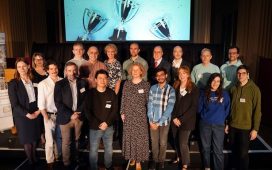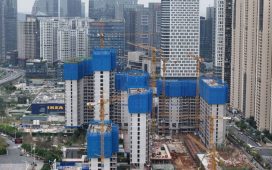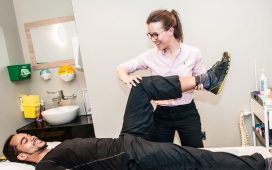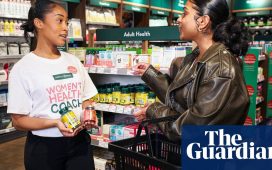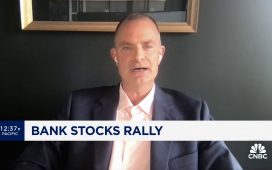From her coffee counter in La Cocina Municipal Marketplace, Santana Tapia has a clear line of sight into every gloomy prediction that has hit San Francisco since the rise of the Covid pandemic.
From the marketplace’s windows in the heart of the city’s troubled Tenderloin District, she notices the decline of foot traffic that has come from employees choosing to work at home rather than travel to their downtown offices, spawning some dire predictions of an economic “doom loop”. And she can see the ravages of the fentanyl epidemic happening all around her, with its record numbers of overdose deaths and scenes of homeless desperation.
Yet Tapia – and other small business operators in La Cocina Marketplace – are mounting a community-minded effort to battle the dire predictions, one cup of coffee and one lunch plate at a time.
Tapia’s coffee house, the Fluid Coop Cafe, which she started last year with two other trans activists, serves up drinks with names like “Expresso Yo Self” and “Love You A-Latte” and hosts open mic nights celebrating the Tenderloin community.
The independent coffee business sits alongside seven restaurant counters that are part of La Cocina’s non-profit incubator for small, women-owned food businesses, featuring dishes like Nepalese dumplings, pupusas from El Salvador and fluffy North African couscous.
While Whole Foods abruptly closed the store it had opened just a year ago in a fancy new apartment complex up the street, citing concerns for employee safety, La Cocina’s entrepreneurs are taking the opposite tack.
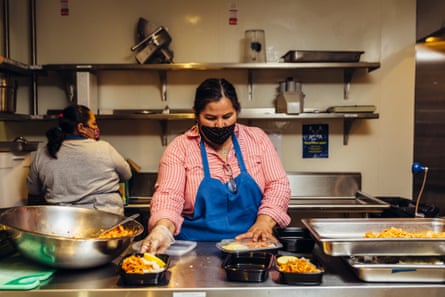
With the brightly muraled food space serving up a $5 community meal and offering a free lending library and computers for public use, the food sellers are pushing against disinvestment and calling on city supporters to lean into the sense of diverse community that has long made San Francisco what it is.
“The reason we have been gaining momentum is we are really focusing on the community and engaging the people who may look like they don’t have a lot of money and those who are unhoused,” said Tapia. “We are breaking down the stereotypes that are keeping people from coming into businesses.”
Still, La Cocina marketplace is battling the same overlapping set of post-pandemic challenges hitting many of the businesses in San Francisco’s central commercial corridor, which centers on a long strip of the city’s Market Street.
In the area around Tenderloin and the South of Market District, scattered tech office buildings including those of Nextdoor and Twitter are sitting mostly empty. The problems of homelessness and drug use that have always haunted the district have been grossly magnified by the pandemic and the rise of the deadly and hyper-addictive drug fentanyl.
In the neighboring Union Square shopping district, top department stores have pulled out one after another. Just last week, Nordstroms, which long anchored the downtown’s glitzy Westfield Center shopping mall, announced it would close.
And in the downtown financial district, with its towering skyscrapers, high vacancy rates in the office buildings have infected the small businesses at street level, leaving vacant storefronts everywhere.
Central to many of these problems is the now unreliable attendance of the 130,000 or so commuters, who used to swell the city’s population during the day as they flocked to their office jobs. Meta, Facebook’s parent company, alone is clearing out of 435,000 square feet of office space in one downtown high-rise. This, in turn, is killing the small businesses that served those office workers lunches, coffees and various other sundries.
The phenomenon of offices clearing out and affecting other businesses was first described as a potential “doom loop” by the New York University professor Arpit Gupta and his co-authors in a paper titled Work From Home and the Office Real Estate Apocalypse.
Studies have shown that San Francisco’s downtown, with its reliance on tech, is taking one of the nation’s heaviest tolls. Office worker visits in the downtown district are down 46% in 2023 from 2019 levels, according to a dashboard from a local business promotion group. Meanwhile the phrase “doom loop” has become a mantra in news articles and discussions about the city.
“There are still customers, just not enough customers,” said Leticia Landa, La Cocina’s deputy director. “It’s not just La Cocina; it’s many, many businesses. These used to be areas with thousands and thousands and thousands of office workers. And now that is no longer the case.”
City leaders have acknowledged the change: “San Francisco downtown, as we knew it, is not coming back,” Mayor London Breed said in her state of the city address on 9 February.
But, she argued: “That’s OK. Empty office buildings have fueled dire predictions about economic doom and screaming headlines about the death of downtown. Let’s keep some perspective. In 1907 [after the great 1906 earthquake], downtown was mostly rubble and ash. That’s considerably worse than today’s shift in how people work.”
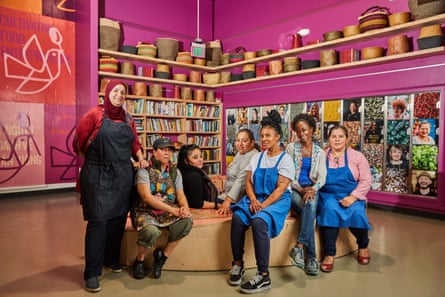
Still, the pain the pandemic wrought is real, especially in the Tenderloin, where La Cocina is located.
At their restaurant, Kayma, inside the marketplace, Chef Wafa Bahloul and her husband, Mounir, serve up a taste of their Algerian heritage with a couscous chicken bowl and a hearty vegan stew along with eggplant marinated in olive oil and Algerian stuffed pastries.
But Bahloul, who immigrated to the US seven years ago, admitted that, when she had to go outside late at night or arrive at the building early in the morning, she was afraid of what she saw.
In the hours before La Cocina’s two-man security team arrives and conducts a daily cleaning, the sidewalks in front of the marketplace are often packed with people sleeping on cardboard and littered with discarded drug paraphernalia. Bahloul said there had been at least one drug overdose in La Cocina’s bathroom and her husband had once witnessed a shooting across the street.
“Hopefully the city can make it more safe,” she said. “It’s hard to make it as a business. What’s going on outside affects everybody.”
The gritty, working-class neighborhood where La Cocina sits just three blocks from the now closed Whole Foods at 8th and Market Streets has long been a pressure point in the economic forces at play in the city’s development.
This edge of the Tenderloin has historically been home to a mix of newly arrived immigrants and working class families with young children, scattered with vibrant ethnic restaurants and office buildings next to services for unhoused people and sex shops. It has long struggled with prostitution and drug use on the streets.
In the years before the pandemic, this area had become the latest flashpoint in the war over gentrification that has raged in San Francisco during the tech boom, with rising tension over the construction of giant luxury apartment developments steps away from the century-old single-room-occupancy hotels that housed some of the city’s poorest residents.
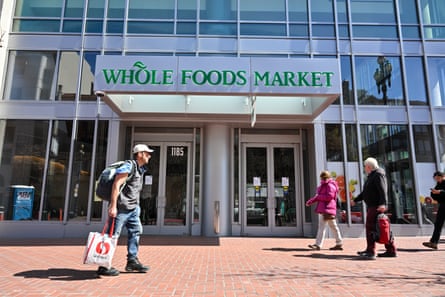
Parts of the area got re-branded as Mid-Market and publicized as a new destination for tech workers by tony real estate firms.
The building that housed the Whole Foods is part of “Trinity Place”, a vast new housing complex with gleaming metallic sculptures, roof decks and ultra-modern lobbies that sits just steps from where unhoused city residents line up for public restrooms and drug users can be seen nodding out on curbsides.
The Market Street Whole Foods, owned by Amazon, opened as a vast, basement-level flagship for the organic foods chain in March of 2022. But it was shuttered this April, with the company posting a small white sign directing customers to its eight outlets in other San Francisco neighborhoods, just a few meters from where the store’s giant “Now Open” banners were still hanging.
“If we feel we can ensure the safety of our team members in the store, we will evaluate a reopening of our Trinity location,” Whole Foods said in a brief statement. While the company didn’t elaborate on its safety concerns, the San Francisco Chronicle reported a person had died of a fentanyl overdose in the store’s bathroom and the store had reckoned with people urinating on the floor and arguing with security guards. Later reports suggested that the store had also been struggling financially.
“If I had to guess, I’d say that no one from [Whole Foods] global or regional took the time to walk around the neighborhood” before opening the store, one former employee told the Chronicle. “Sales weren’t too great for the supposed flagship store of the region.”
The closure became the latest talking point in a debate over how homelessness and open-air drug use should be handled in the city. The mayor and others say crime has gone out of control and have called for more policing and arrests of drug dealers. More progressive city voices have pushed for a more empathetic approach: giving unhoused people more housing and treatment and offering safe spaces for drug users to use under supervised conditions.
The fentanyl emergency has intensified in San Francisco this year, with a person dying of an overdose every 10 hours during the first quarter – a 41% increase over last year. More than 7,750 people are homeless in the city on any given night, according to the 2022 homeless count, a single-day estimate that is considered an undercount.
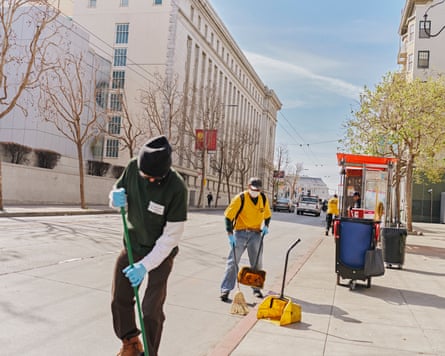
Yet Magnus Lofstrom, an expert in criminal justice with the Public Policy Institute of California, said that the current rhetoric on crime wasn’t borne out by statistics. The most recent statewide statistics, which are for 2021, show that violent crime was down for San Francisco compared with just before the pandemic. And while retail theft was up somewhat, property crime as a whole was down compared with 2019 as well.
“The perception of crime might have an impact on the foot traffic businesses are seeing,” he said. “I’m stressing the perception, because the perception is opposed to what we actually see in the crime data.”
Matt Long, a tech worker who came down from his apartment in the Trinity Place complex to pick up some chicken for dinner one chilly evening last month, was shocked to find Whole Foods closed.
He said he didn’t support more drug arrests, but something needed to be done to solve the fentanyl crisis unfolding at all hours of the day and night around his neighborhood. He’d like to see more housing for those experiencing homelessness and more safe spaces off the streets for drug users.
“Whatever the city has been doing isn’t working,” he said. “We need a more holistic solution.”
Landa, of La Cocina, agrees that the Tenderloin’s problems of homelessness and drug use have become a “scapegoat,” sometimes taking the blame for the overall economic problems of the city.
“So much of it is just about the perception more than the reality,” said Landa. “It’s such a vibrant, beautiful neighborhood. Yes, there is also drug dealing and there is also homelessness. And those are frustrating things. But instead of just focusing on those pieces, wouldn’t it be so much better for everybody if we focused on the wonderful things and celebrated them and supported them?”
Some are calling for an approach to rebuilding San Francisco’s commercial future that is more like La Cocina’s, emphasizing the diverse communities that were there long before the tech boom started transforming San Francisco a quarter-century ago.
From downtown business boosters to leftwing supervisors, there’s a growing chorus of voices arguing that the city’s business districts need to move away from the intense focus on tech development and lean into including the city’s diverse communities again.
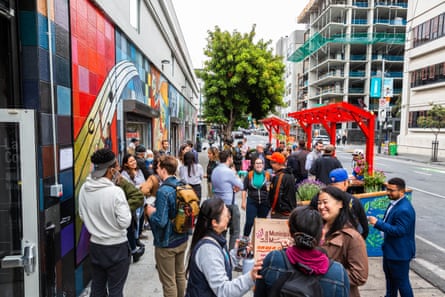
“I don’t believe in the doom loop,” said Robbie Silver, the director of Downtown SF Partnership, which concentrates on improving a 43-block area around the Financial District. “But for downtown San Francisco to really thrive as an inclusive neighborhood again, it needs to have a more diverse portfolio.”
“We are not giving up on office space, but we need to mix it up with residential, hospitality, with arts and culture, education, and with life sciences. That will make it much more resilient against, God forbid, any future pandemic or economic crash.”
The group has been organizing community-spirited events to draw people from other parts of the Bay Area in, including a planned “Drag Me Downtown” event, during San Francisco’s Pride celebration in June that will feature pop-up performances by drag queens around various downtown bars and restaurants.
The city supervisor Dean Preston said business was booming in San Francisco’s many quirky, residential neighborhoods that spread out in other parts of the city, such as Haight-Ashbury, which still draws visitors based on its history as the counterculture capital of the 60s Summer of Love; the Castro, long a beacon of gay communities; and Japantown, with its five-tiered pagoda and shabu-shabu restaurants.
He thinks that instead of relying on dreams of a big money tech transformation, the city’s commercial core needs to cultivate some of the same types of community spirit that make other SF neighborhoods, like Noe Valley, North Beach and the Haight, thrive.
“The model of this kind of booming tech downtown driving the economy is just not the future,” he said.
Meanwhile, in La Cocina’s kitchen, Bahloul is hoping that, as spring weather sets in, more people will come out and try some of her family’s Algerian hospitality.
“I’m asking for support from the city and the people of the city,” she said. “We’re small businesses. Come out and support us.”

